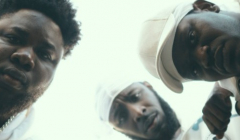
CALM and T&Pm lean on drill music to break mental health taboos
The creatively bold campaign utilises comedy to help create the space for Generation Z to talk about their mental health.

Different typefaces have different connotations for consumers

It’s a common scenario - you receive a quote for something or get an email from an unknown address, it seems legitimate at first but something about it feels off. The type looks cheap! Is it Comic Sans? Is this a scam you think to yourself? Brands rely on typography to convey trust and reliability. Even if the logo, photography and graphic design are flawless, the second that looks out of synch is the second that doubt can creep in.
Designers have used powerful fonts to give brands a certain mood and feel for decades, but the power that fonts have in shaping our emotional responses and loyalty to a brand or logo has only been explored in recent years. Decades of research and thought have gone into branding and the psychology of colour, but far less attention has been paid to the science of type and emotion, which considering that we absorb hundreds of typefaces on a daily basis is surprising.
Keen to understand how fonts drive experience and feelings, and assess the effectiveness of different typefaces in different situations, Monotype recently teamed up with neuroscience company Neurons to conduct the first research of its kind. More specifically, we wanted to understand how fonts influence our response to taglines and slogans? And do they really build trust between brands and consumers?
Brands rely on typography to convey trust and reliability
Marie Boulanger, Brand Designer at Monotype
For the study, we surveyed 400 people using three kinds of stimuli: single words, a sentence using those words, and a sentence with the words including a brand. Each of these was set in three typefaces – FS Jack, a humanist sans; Gilroy, a geometric sans; and Cotford, a languid serif. While these types look similar to brands consumers have seen, they were not associated with actual brands to avoid pre-existing associations. Respondents rated the combinations using a range of emotional metrics – such as how sincere, memorable, trustworthy or confident they felt. These are keywords that come up time and again in brand mission statements and marketing packs.
Type is the material that wraps around language, but no type choice can be judged without taking into account the overall message itself. To test how type affects our reaction to language, we chose words conveying core brand values, including quality, trust, and innovation - keywords that come up time and again in brand mission statements and marketing packs. Setting ‘quality’ in Cotford Display Regular sparked a 13% increase in people’s judgment of relevance, a 10% increase in how memorable it was, and a 9% increase in trustworthiness.
Serif designs such as Cotford have long been associated with the world of luxury, meaning people’s subconscious reaction is driven by years of cultural association. It’s perhaps no surprise that our research showed Cotford Display Regular boosted people’s positive perceptions of the word ‘quality’. FS Jack, while a sans, has a double-storey a and g, which ties it to a more humanist way of constructing letters. This could explain the uplift in how prominent, innovative, and unique people judged a single word set in FS Jack Regular to be. It also backs the assumption that styles rooted in calligraphy, or that somehow still retain its logic, prompt a deeper, instinctive emotional reaction. FS Jack Regular created a 9%, 7% and 3% increase in how innovative, prominent and unique a single word is perceived as being.
Proving that our brains have such a significant response to letter shapes should put type choice at the top of the branding agenda. And it supports our belief that fonts influence not just how easily people understand something but the way it makes them feel.
There’s plenty more work to be done and with the second phase of research with Neurons going ahead in September this year, we’re hoping to take this study to the next level - delving into other variables such as demographical and regional differences and to see if culture has a large impact on findings. We will also be diving deeper into brand values and different verticals.
For now, we know that different fonts can elicit different emotions based on the same word. These qualities can guide meaning, they leave a subconscious mark on the brain that alters our connection with the brand. And on the flip side, brands that take type for granted and use a poorly chosen typeface risk alienating their customers and negatively affecting the bottom line.
Through this study, we’ve managed to validate some of our beliefs and show how brands can harness the intrinsic power of type. Much like the psychology of colour revolutionised how marketers communicate and engage with customers at a deep level, applying the same approach to typography will give brands tools and knowledge to strengthen their relationships with their audience. We are proud to dive into the unknown and share our findings with the creative world.
Marie Boulanger is Brand Designer at type and tech company Monotype based in London. She is also an independent type designer, working with various foundries and agencies on custom letters and typefaces for plethora of different projects
Looks like you need to create a Creativebrief account to perform this action.
Create account Sign inLooks like you need to create a Creativebrief account to perform this action.
Create account Sign in